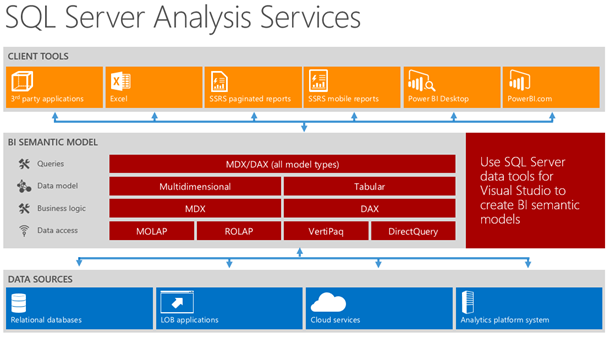Enable business insights for everyone with SQL Server 2016: Part 1
This post was authored by Kasper de Jonge, Senior Program Manager, SQL Server Analysis Services.
This is the first installment of a two-part series. Read on to learn how SQL Server 2016 Analysis Services (SSAS) can provide fast access to data to allow analysis at the speed of thought and stay tuned for part two, where we discuss the specific improvements made to SSAS for SQL Server 2016.
Many companies are generating more and more data, and the increased use of mobile devices, sensors and business applications adds to this trend every day. With this wealth of information and the business opportunity unlocking it provides to organizations, it has become increasingly important to allow more business users to easily access data to help them make better decisions when and where they need to.
Many organizations have two types of data users. The first type is those who geek out on data, are passionate about it, and know where to locate the information and manipulate it into insights by using tools such as Excel or Power BI Desktop. They are the ones who often discover hidden insights, solve important ad-hoc questions that arise in an organization and tend to be on the cutting edge of technology and data knowledge. The second type (and majority of data users) often don’t have the same inclination to search for data but still need access to make informed decisions. This group of data users often specifically benefit from SQL Server Analysis Services (SSAS) by accessing data models that they can easily understand, with the tools they are familiar with. IT developers can use SSAS to empower these users to unlock business intelligence based on data that can be trusted, is reusable and easy to interpret.
Create powerful BI Semantic Models and transform complex data
IT developers play an important role in helping business users unlock data that produce actionable insights. For example, they can create an Analysis Services BI Semantic Model that allows business users to explore data and surface insights through visualization tools. When connecting to a BI Semantic Model, business users don’t have to worry about where the data is coming from or how it is joined together.
The model provides BI professionals with an intuitive abstraction (as opposed to complex data) by creating either a traditional multidimensional model or a simpler tabular model. On top of that, they can apply specific business logic to the data using a powerful calculation language that allows them to describe logic in forms such as year-to-date or year-over-year change.
Flexible data access layer
The BI Semantic Model also provides fast access to data to allow analysis at the speed of thought. Historically, this has been done by loading data into the analysis storage engine. Given that the amount of data at some companies is growing at an unprecedented rate, organizations have needed to increase scale by investing in infrastructure and databases, often utilizing in-memory to handle the increased volume. However, when more data needs to be moved from source systems to the BI system to widen access, the length of time required to retrieve data increases every day.
For some organizations, the volume of data provides a challenge and they need a solution that no longer has a dependency on moving data from the source system. In addition to the option to load the data into memory, SQL Server Analysis Services provides the capability to directly connect models to the data sources. This option might be especially attractive when the source data is available on high-performing infrastructure.
The image below shows an overview of the BI Semantic Model:
 Figure 1: Overview of SQL Server Analysis Services (SSAS).
Figure 1: Overview of SQL Server Analysis Services (SSAS).
We have only scratched the surface on this important topic. In a follow-up blog post, we will share more information on the enhancements made for SQL Server Analysis Services in SQL Server 2016. Further information on these updates can also be found via our videos sessions from Data Driven 2016 on the Tabular semantic model and Analysis Services DirectQuery. The latest details can always be found on the Analysis Services and PowerPivot Team Blog.
See the other posts in the SQL Server 2016 blogging series.
